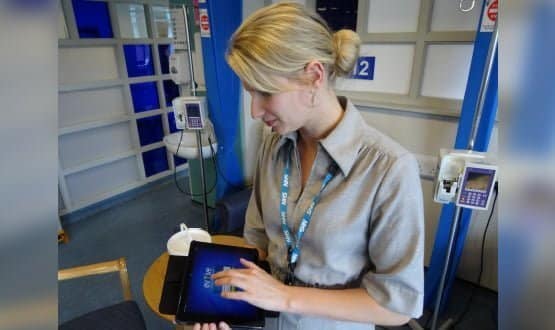Cancer – the big IT
- 19 August 2014

On a grey and gloomy day in the north west of England, it is a surprise to see how bright and welcoming the Clatterbridge Cancer Centre’s Wirral site is for its patients.
“You’d think it would be a sad place, but it’s really not,” says one of the trust’s staff, as patients pat a dog brought in to see them in one of the airy waiting areas.
Signing for Meditech V6.0
Clatterbridge is one of the largest networked cancer centres in the UK, treating more than 30,000 patients a year across nine sites and clinics in Merseyside and Cheshire.
Its capabilities and facilities are set to expand further with its Transforming Cancer Care project, at the heart of which is a new, £118m specialist cancer centre in central Liverpool.
This is set to open in 2018 and, while much attention has inevitably been focused on the architect’s gleaming, concept design, it is the trust’s overhaul of its existing IT systems that will arguably play a bigger part in making sure that the project is a success.
The trust recently signed a contract with Centennial MIT to implement the Meditech Version 6.0 EPR system at its existing sites, following an OJEU competitive dialogue procurement.
The first phase of the go-live will take place next year, with the aim of making sure that it is running smoothly and efficiently by the time the new centre is opened.
Some good IT, but a lot of paper
Thomas Poulter, the trust’s IM&T director, stresses that the decision to implement a new EPR was carefully considered, given the strength of its existing systems.
“I think it’s fair to say we’re quite advanced already from an EPR perspective. The systems we’re planning to replace have served us well over the years, and we’ve invested a lot of time and money in rolling them out.”
The trust signed a ten-year contract with IMS Maxims for its EPR in 2002, outside the National Programme for IT, with Ascribe providing the e-prescribing and pharmacy systems.
Beverley Talbott, the trust’s EPR project manager, says the existing systems work well and are liked by staff, but she is hopeful that the Meditech EPR will provide more flexibility and functionality.
The new system is also intended to speed up the trust’s plans to become paperless, with Talbott describing current paper use at the trust as a “mixed bag”.
Paper is steadily being removed from the wards and departments, but the bulging briefcases of case files in the medical records office show that paperless is still a work in progress.
First of type for oncology
Poulter says the trust looked at taking Lorenzo through the revised deal that the Department of Health negotiated with CSC, to put the difficult days of NPfIT behind it in 2012.
The deal included central funding for trusts that still wanted the system. But Poulter says that, in the end, a lack of “evidence and confidence” meant the trust decided to negotiate with IMS to extend the Maxims contract to 2015, upgrading some of the functionality.
As part of the procurement process, Poulter and his team re-visited the Lorenzo option and conducted an evaluation of the system, but still felt that it came up short in some crucial areas.
“It didn’t have some of the oncology-specific functionality which we refer to as a ‘red-flag’ requirement,” he says. “If it didn’t have it, it just wasn’t going to work for us.”
The EPR project team also visited a number of hospitals to assess Meditech V6.0 and to see how it worked in an oncology context, including the Hays Memorial Hospital in Kansas.
The trust will now implement an Anglicised version of the system’s oncology module, as a first of type deployment within the NHS. “It stood out as being the best integrated and comprehensive system, and it met more of our detailed functional requirements as an oncology centre,” Poulter says.
Margot Mercer, the trust’s assistant pharmacy manager, says Meditech also has a strong e-prescribing system, which will be valuable when it comes to dealing with the complexity of prescribing for chemotherapy.
Doses are calculated individually for each patient, and taken over more than one day in cycles. “To prescribe it is quite complicated, and can be a high risk area,” Mercer says.
While the Ascribe system is integrated with the Maxims EPR, she says the higher level of integration within the Meditech system will “push the information out as opposed to needing to dig for it.”
Going mobile
Dr Peter Kirkbride, the trust’s medical director, has been appointed as the project sponsor. He says clinical engagement and involvement is vital to the success of the EPR implementation, as well as the trust’s plans for the new cancer centre.
“It doesn’t matter how good the system is if the people who use it aren’t taking the step forward, so it’s really important that we involve clinicians and users every step of the way. The plan isn’t just about building a new hospital – the IT does underpin it.”
The opening of the new Liverpool centre in 2018 will mean there are up to ten sites or clinics that staff could work at, and Kirkbride says a successful rollout of the EPR will ensure that the trust’s “mobile workforce” can have access to a patient’s record wherever they are working.
“We’re moving forward with a much more flexible and integrated EPR, so at all three sites it doesn’t matter where the patient turns up or who they see, we will always have the record there for them.”
Poulter says work on mobile solutions has already started, with iPads being rolled out to all medical staff over the past 12 months.
An iPad-specific app has also been recently rolled out for the trust’s Evolve electronic document and records management system to provide clinicians with remote access their patients’ case files.
The Evolve system is an important part of the trust’s moves towards becoming paperless: project manager Jeni Bradshaw says the case files of its 22,000 active patients are gradually being scanned in to eliminate the bulging briefcases of records.
Sorting out the infrastructure and analytics
A number of other projects are also being undertaken to support the EPR implementation and revamp Clatterbridge’s IT infrastructure ahead of the new centre opening.
The trust is working with CACI on a trust-wide data warehouse and electronic dashboards project, including a patient-level costing system, clinical activity dashboards, and automated report distribution.
This will be able to produce daily, weekly and monthly reports on finance, waiting time and activity, while giving the board access to real-time data via their iPads during meetings.
A network upgrade is also taking place, including a replacement of the trust’s wireless internet network and the provision of voice over IP and unified communications systems, while the trust has already virtualised its servers and is contemplating a desktop virtualisation project.
The changes taking place on the systems front are also being supported at a managerial level.
Last year, Dr Richard Griffiths was appointed as Clatterbridge’s first chief clinical information officer – a move that Kirkbride says has provided a clinical leader who can effectively advocate for greater use of technology.
“The question is more, ‘Why didn’t it [the role] already exist?’ You need to have that lead clinician to be able to sit at the table and give their medical input because there’s no doubt that when doctors speak, the board listens.”
It’s all happening by 2018
Poulter says all of these changes are connected to the Transforming Cancer Care project, with the centre’s opening date of 2018 conveniently coinciding with health secretary Jeremy Hunt’s ambitious deadline for all trusts to become paperless.
“We don’t expect to have a physical medical records library in the new hospital, so by the time it’s bedded in, we’ve got some time to make any adjustments we need to.
“At the moment, we’re making good progress towards paper-light, and my personal belief is that paperless by 2018 is an achievable target that we should be working towards.”




